

HRV Demographics, Part 3 – Health, Medication & Guidelines. In this third part to the HRV Demographics series, we will cover two of the biggest health factors and research on some of the common diseases that affect heart rate variability, as well as how medication can alter your HRV values and potentially cause them to be incomparable to your relevant demographics.
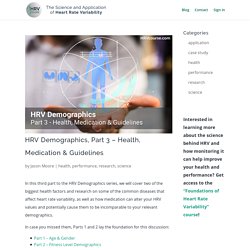
In case you missed them, Parts 1 and 2 lay the foundation for this discussion: HRV Connection to Health and Disease A growing number of studies analyzing cardiovascular, respiratory, gastrointestinal, mental health diseases, and various other pathological conditions show that Heart Rate Variability can significantly decline with decreased health. In fact, changes in Heart Rate Variability have been correlated with 9 out of the 10 leading causes of death in the United States, including: Autonomic Imbalance Linked to Disease There is growing evidence for the role of the autonomic nervous system (ANS) in a wide range of diseases such as those mentioned above.
Inflammation & Immune System. Case Study: The Effects of Diet on Heart Rate Variability. There are countless diets and nutrition plans being touted as “the solution” but with such varied results.
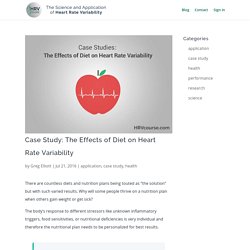
Why will some people thrive on a nutrition plan when others gain weight or get sick? The body’s response to different stressors like unknown inflammatory triggers, food sensitivities, or nutritional deficiencies is very individual and therefore the nutritional plan needs to be personalized for best results. The body’s response to different stressors like unknown inflammatory triggers, food sensitivities, or nutritional deficiencies is very individual and therefore the nutritional plan needs to be personalized for best results. Depending on a person’s current health condition (especially gut health), activity level, and genetic predisposition to food allergies/sensitivities, the same diet can cause drastically different results for different people. Weekly HRV vs. Daily HRV. As you seek to optimize your health or performance, it is a best practice to regularly check your progress and make adjustments to continue to get the best results.
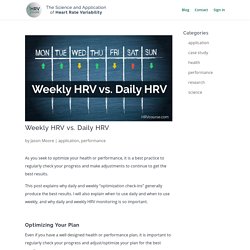
This post explains why daily and weekly “optimization check-ins” generally produce the best results. 3 Steps to Treat Chronic Pain Using HRV. I was 21 years old, a student-athlete playing DII basketball in the NCAA, and sleeping with my mattress directly on the floor.
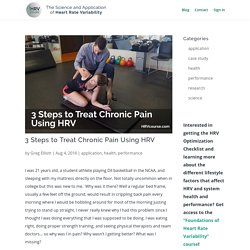
Not totally uncommon when in college but this was new to me. Why was it there? Well a regular bed frame, usually a few feet off the ground, would result in crippling back pain every morning where I would be hobbling around for most of the morning justing trying to stand up straight. I never really knew why I had this problem since I thought I was doing everything that I was supposed to be doing. I was eating right, doing proper strength training, and seeing physical therapists and team doctors… so why was I in pain? 1 in 5 people worldwide suffer from some form of chronic pain, totaling upwards of $600 to 700 billion from health care costs and lost productivity just in the US and Canada alone.
A recent meta analysis study showed those suffering from chronic pain have significantly low HRV values compared to those who live without chronic pain. Takeaways. Your Coach as a Stress Manager. Physical training is one of the most potent stressors that draws many people to learning about Heart Rate Variability.
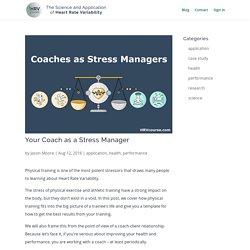
The stress of physical exercise and athletic training have a strong impact on the body, but they don’t exist in a void. In this post, we cover how physical training fits into the big picture of a trainee’s life and give you a template for how to get the best results from your training. We will also frame this from the point of view of a coach-client relationship.
Because let’s face it, if you’re serious about improving your health and performance, you are working with a coach – at least periodically. Coach-Client Success For most people, getting “a little more fit” is easy – at least temporarily. When it comes to actually making big, targeted gains in performance and fitness in the shortest amount of time and with the least chance of failure, nothing gets you better results than working with a quality coach or trainer. Training and Everything Else School and Work. Alcohol. The 8 Biggest Mistakes Made When Measuring Heart Rate Variability. As powerful and easy-to-use as Heart Rate Variability is, it is also easy to use it incorrectly or skew your measurements beyond usefulness.

After helping thousands of people from around the globe measure and analyze their HRV, here are the biggest and most frequent mistakes we’ve seen and how to avoid them. The following discussion assumes the use of short-term (under 5 minutes) rested state HRV readings. Mistake 1 – Assuming A Low Reading Is Always Bad Chronically low Heart Rate Variability is generally not favorable. However, a single or handful of low HRV readings is not always bad. An acute HRV drop after a hard workout or series of workouts that returns back to normal or better within a few days or weeks’ time. Heart Rate Variability & Concussions. Through news articles, special reports, blockbuster movies, and even the involvement of the US Congress, we now know that there is irreversible physical and psychological damage caused by concussions.
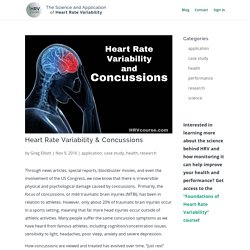
Primarily, the focus of concussions, or mild traumatic brain injuries (MTBI), has been in relation to athletes. However, only about 20% of traumatic brain injuries occur in a sports setting, meaning that far more head injuries occur outside of athletic activities. Many people suffer the same concussion symptoms as we have heard from famous athletes, including cognition/concentration issues, sensitivity to light, headaches, poor sleep, anxiety and severe depression. How concussions are viewed and treated has evolved over time. “Just rest” advice from doctors use to be the common way to handle MTBIs. Heart Rate Variability is an example of an objective tool that can be used along with subjective measurements to help determine a person’s status in the healing process. 1. 2. 3.